The 1st North Midland Divisional Camp
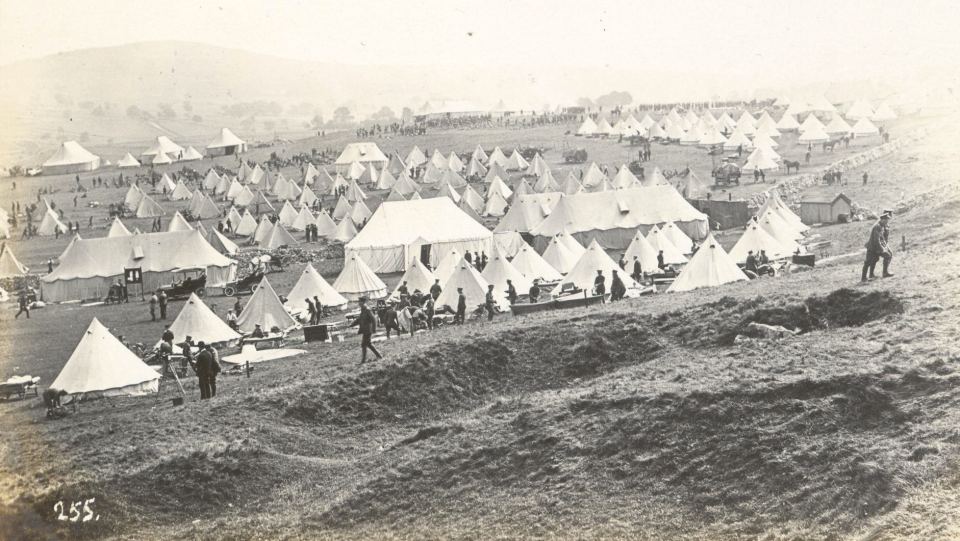 The North Midland Division Camp (HP Hansen Series #255)
The North Midland Division Camp (HP Hansen Series #255)
The transformation of the countryside, bounded by Hindlow Railway Station, Chelmorton Road-end and Mr Wood’s farm at Heathfield, into the North Midland Divisional Camp began at the end of June when an advance party of 25 members of the Army Ordinance Corps set foot upon the ‘open fields’ of Derbyshire. A row of store tents were pitched that extended from just below the Railway Station to the Ashbourne Road and hundreds of tons of materials and stores were housed in them. Three-inch and 6-inch water supply pipes were laid from Stanley Moor reservoir to the Camp in order to provide the 65,000 gallons of fresh water that was needed daily. The Divisional Headquarters also contained a military post and telegraph office. The General Officer Commanding was Brigadier-General Hugh James Archdale, C.B., C.M.G. (1854-1921); whilst his Staff included General Staff Officer Colonel WAM Thompson R.A., Dep. Asst. Adjt. & Qr.-Mstr.-Gen. Captain D Powell R.W.F., Lieutenant G Cantrell Hubbersty and Brigadier Williams.
The total compliment of the Camp was expected to be 358 Officers and 12,239 men and the cost in pay and allowances for one week of the Camp was estimated to be between £18,000 and £20,000.
 Map of Hindlow and the surrounding area dating from c1900.
Map of Hindlow and the surrounding area dating from c1900.
In the centre is Shallow Farm (now renamed Shallow Grange and hosting a caravan and camping site). This farm forms the background for several pictures from this Divisional Camp, most notably the Brigade Church Parade and Inspections.
To the south east of the farm was Hindlow Station on the Cromford & High Peak Line, which may have been the station that many of the men arrived to camp by. The rest of the North Midland Division were camped in the Valley along the Buxton to Ashbourne road and close to the C&HPR. The surrounding area of Derbyshire provided a variety of different landscapes and proved to be ideal for manoeuvres, indeed many of the training exercises were based close to Earl Sterndale, a small village about 4 miles march away. Much of the area to the west of the disused C&HPR railway is now a Limestone Quarry and Hindlow Station no longer exists. The approximate positions of the 5th (purple), 6th (red), 7th (blue) and 8th (green) Battalion Camp sites are indicated by the boxed areas.
The 6th (Derbyshire) Battalion

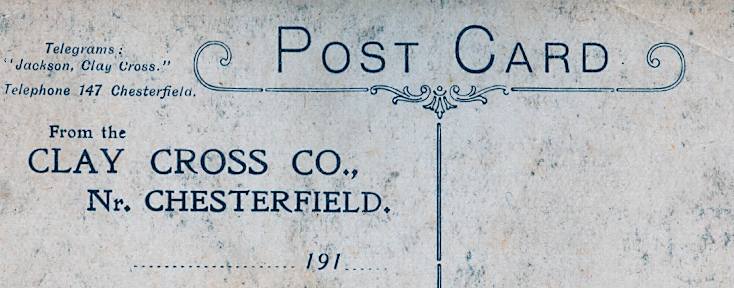 Three postcards from the “Clay Cross” Series of 1910 (unknown publisher #109, 110 & 114).
Three postcards from the “Clay Cross” Series of 1910 (unknown publisher #109, 110 & 114).
These three cards of part of a series of 25 ‘unique in character’ that depict the Clay Cross Company. In the top picture is a Clay Cross Collier “winning his bread” and “serving his country” In the middle picture our mounted men of the Battalion and probably part of the transport section and finally in bottom picture members of “G” (Clay Cross) Company are on the platform of the Midland Railway Station ready to board a train to the camping grounds near Buxton.
 “The 6th Battalion” (HP Hansen YMCA Series #4)
“The 6th Battalion” (HP Hansen YMCA Series #4)
 “The 6th arrive” (HP Hansen YMCA Series #5)
“The 6th arrive” (HP Hansen YMCA Series #5)
The 6th Battalion marched into Camp on the 31st July with 26 Officers, 46 Sergeants, 36 Corporals, 15 Drummers and 773 men. 127 NCOs and men returned home at the end of the first week on August 7th and 65 NCOs and men joined for the second week of camp.
In the first picture Lieut.-Colonel Jackson is seated on his horse with Major Goodman to his left and Captain Atkinson to his right. The Officer immediately behind Atkinson is Captain Hopkins, who was in Command of “A” (Chesterfield) Company at this time, whilst Lieutenant Victor Robinson is to the left of the column. In this shot the men are seen marching around the bend at Brierlow Bar close to the main Buxton to Ashbourne Road.
In the second picture taken only a few minutes later the men are again seen marching along a typical Derbyshire stonewall enclosed lane to their camping ground at Shallow Farm. The Signal section are the leading unit closely followed by the Battalion band. Recognisable in the background is Brierlow Bar Farm, whilst Lieut.-Colonel Jackson can be seen riding his horse mid-way down the column of men. The tents of the rest of the North Midland Division can be seen in the distance running alongside the Buxton Road. These camps would have contained the men of the Staffordshire and Lincoln and Leicestershire Brigades as well as men from the Divisional Artillery, Field Ambulance and Army Service Corp Units. Note that these two postcards are numbered consecutively and are part of a YMCA series of photographs taken during the Camp.
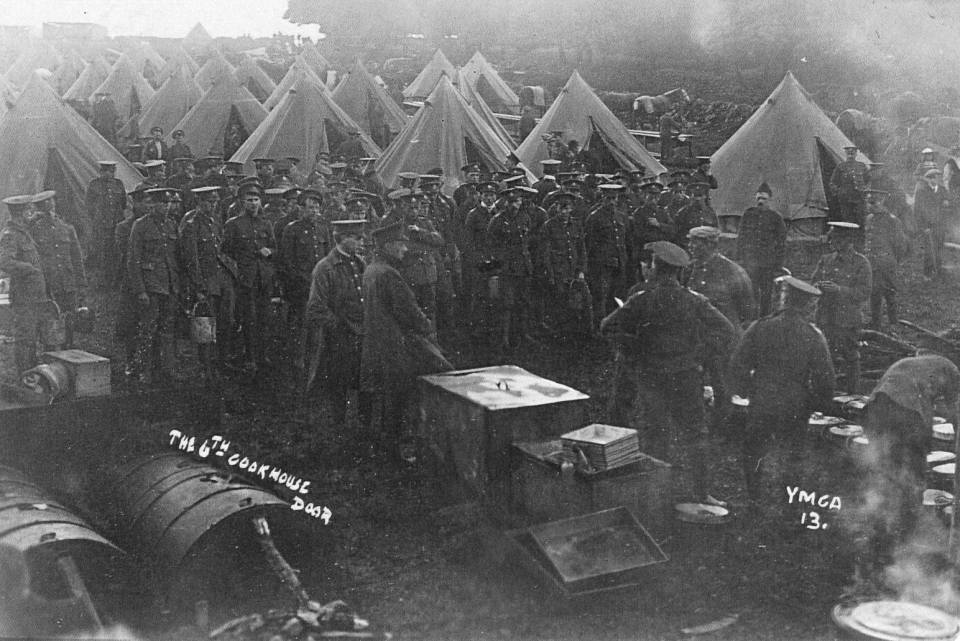 “The 6th Cookhouse door” (HP Hansen YMCA Series #13).
“The 6th Cookhouse door” (HP Hansen YMCA Series #13).
Having reached Camp the men are keen to eat . During the Camp, 65 tons of meat and 12,000 half-quartern loaves (a loaf having a weight when baked of 800g) were consumed. Each Territorial Soldier paid one shilling per day to the mess fund for ‘extras’ such as tea, potatoes, milk sugar and bacon. Meal times during Camp were generally; breakfast at 8 am, dinner at 2.30 pm and tea at 5 pm. 116 Sergeant George Hoult of G Company and 19 assistants provided hot meals for the 980 men of the Battalion that were in Camp. In order to do this they used a combination of Aldershot ovens (seen at bottom left of the picture) and camp kettles. The High Peak news reported that “the men had never been fed so well at Camp before”
 George Hoult was born in Clay Cross in 1880 and was a miner by trade. He original enlisted into the 2VB, Sherwood Foresters (Derbyshire Regt.) and in 1906 he attended a 42 day course to obtain an ‘Aldershot cooking certificate’. He was awarded the TFEM on 1st April 1910. George later re-enlisted into the Sherwood Foresters on 11 September 1914 and was posted to the 11th Battalion. He arrived in France on 27th August 1915, but returned to England in August 1916 and was discharged in July 1917. He was awarded the 1914-15 Star, British War and Victory Medal and a Silver War Badge.
George Hoult was born in Clay Cross in 1880 and was a miner by trade. He original enlisted into the 2VB, Sherwood Foresters (Derbyshire Regt.) and in 1906 he attended a 42 day course to obtain an ‘Aldershot cooking certificate’. He was awarded the TFEM on 1st April 1910. George later re-enlisted into the Sherwood Foresters on 11 September 1914 and was posted to the 11th Battalion. He arrived in France on 27th August 1915, but returned to England in August 1916 and was discharged in July 1917. He was awarded the 1914-15 Star, British War and Victory Medal and a Silver War Badge.
The 5th (Derby) Battalion
 “The 5th” (HP Hansen YMCA Series #29).
“The 5th” (HP Hansen YMCA Series #29).
 The 5th Battalion, which had marched from Derby to Hindlow Camp, a distance of nearly 40 miles, arrived on Monday with the Robin Hood’s Bugle Band and the 6th Battalion’s Brass Band leading them. This postcard was sent by Thomas Ison of “H” (Swadlincote) Company to his fiancé Ada Clements on 4th August. At the time of writing Ada was a domestic housemaid for Thomas Simmonds who had been a teacher of Science and Art at the Derby School of Art.
The 5th Battalion, which had marched from Derby to Hindlow Camp, a distance of nearly 40 miles, arrived on Monday with the Robin Hood’s Bugle Band and the 6th Battalion’s Brass Band leading them. This postcard was sent by Thomas Ison of “H” (Swadlincote) Company to his fiancé Ada Clements on 4th August. At the time of writing Ada was a domestic housemaid for Thomas Simmonds who had been a teacher of Science and Art at the Derby School of Art.
The Colour Sergeant wears the crossed rifle and crown badge of best shot in his unit.
The 7th (Nottingham) Battalion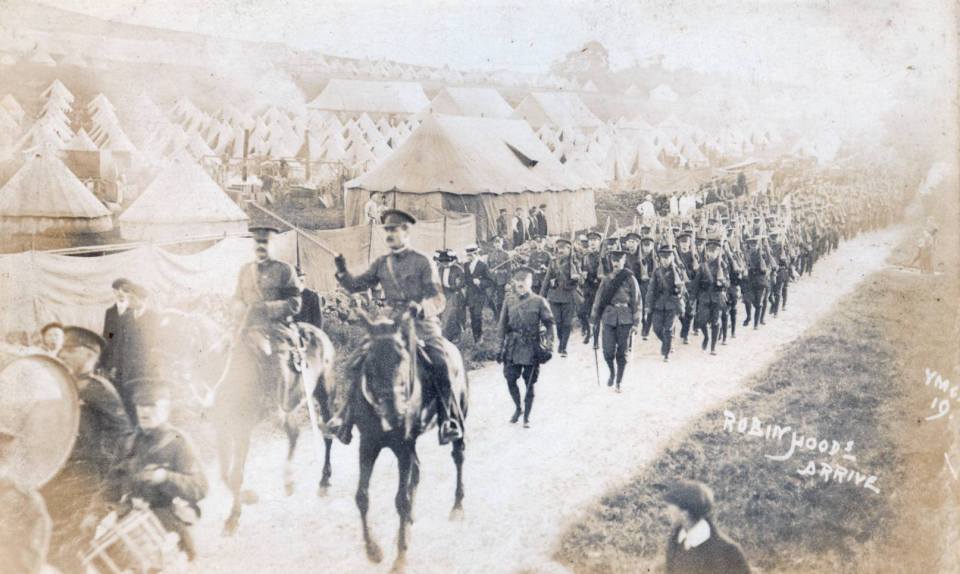
Robin Hoods arrive (HP Hansen YMCA Series #19)

“Robin Hoods” (HP Hansen YMCA Series #15)
This photograph was taken from the eastern edge of the Brigade camp looking west towards the 6th Battalion camp ground. An advance party from the 7th Battalion, which comprised the Quartermaster, Captain WH Newham and 19 Other ranks proceeded to Hindlow on July 28th to establish the Battalion camp and prepare for the arrival of the rest of the Battalion. Headquarters staff and the rest of the Battalion paraded in the Market Square in Nottingham at 1.40 pm on Sunday 31st July, marched to the Midland station and entrained in two special trains for Buxton.
 This postcard was sent by Tom Breaks to his sister Ellen at the City Fire Department in Nottingham. Tom Breaks was a Fireman by trade and in 1915 he enlisted into the Army Service Corps (Motor Transport) and was sent to France as an Auxiliary Fireman with the 659th Company ASC on the 9th May 1916. He was Mentioned in Dispatches and awarded the Croix de Guerre in 1917. Unfortunately his Notts and Derby Service record no longer exists so it is not possible to piece together his pre-War Territorial Service with the Colours.
This postcard was sent by Tom Breaks to his sister Ellen at the City Fire Department in Nottingham. Tom Breaks was a Fireman by trade and in 1915 he enlisted into the Army Service Corps (Motor Transport) and was sent to France as an Auxiliary Fireman with the 659th Company ASC on the 9th May 1916. He was Mentioned in Dispatches and awarded the Croix de Guerre in 1917. Unfortunately his Notts and Derby Service record no longer exists so it is not possible to piece together his pre-War Territorial Service with the Colours.
 Robin Hood Bugle Band (HP Hansen YMCA Series #49).
Robin Hood Bugle Band (HP Hansen YMCA Series #49).
This particular card was sent from 217 Pte. John Lineker to his friend Will Herrick at the Duke of Newcastle Inn in Nottingham.
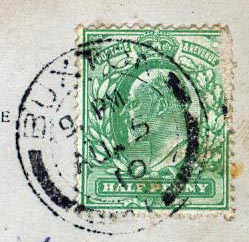 John was a packer from Nottingham and enlisted into the Nottinghamshire Volunteers in May 1900 and the 7th Battn on 20th April 1908 aged 25. He served in France from 28th February 1915 to 31 April 1916 and was discharged in May 1916 [KR Para 392 (XXI)] due to termination of engagement.
John was a packer from Nottingham and enlisted into the Nottinghamshire Volunteers in May 1900 and the 7th Battn on 20th April 1908 aged 25. He served in France from 28th February 1915 to 31 April 1916 and was discharged in May 1916 [KR Para 392 (XXI)] due to termination of engagement.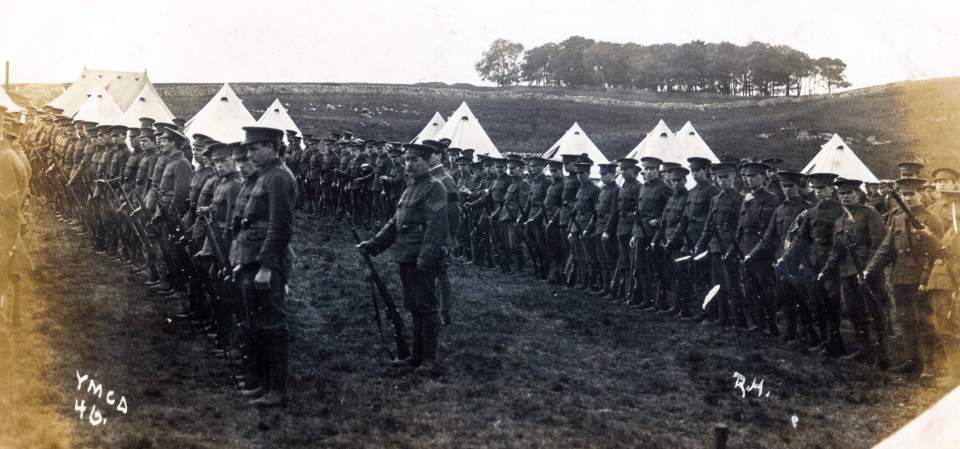
“Robin Hoods” (HP Hansen YMCA Series #46)
The 8th (Nottinghamshire) Battalion
Various Camp Scenes at Hindlow
 A panoramic sweep of the camp site at Hindlow “Buxton Notts & Derby” (HP Hansen Series #1, #2 and #3)
A panoramic sweep of the camp site at Hindlow “Buxton Notts & Derby” (HP Hansen Series #1, #2 and #3)
In the foreground are the bell tents that served as sleeping quarters for the men, whilst the large mess tents and cookhouses are closer to the road. Access to the camp was through a gate on the Chelmorton road close to the copse of trees and in this picture a horse drawn tram can be seen moving along the Chelmorton Road. It was noted in the High Peak News that all of the tents of the 6 Battalion were lit by electricity. In the main camping area the tents are arranged into 8 rows of 12-14 tents, suggesting that each of the 8 Companies occupied a row of tents with approximately 8 to 10 men per tent.
 Post card from Walter Tomlinson sent to his wife ‘Lizzie’ at 8 Cross Street in Derby (HP Hansen YMCA Series #52).
Post card from Walter Tomlinson sent to his wife ‘Lizzie’ at 8 Cross Street in Derby (HP Hansen YMCA Series #52).
“Dear Lizzie, just a line to say I am quite well and that i think the train leaves Buxton at 3-30, it will be about 5 when we arrive, from your ever, Walter.
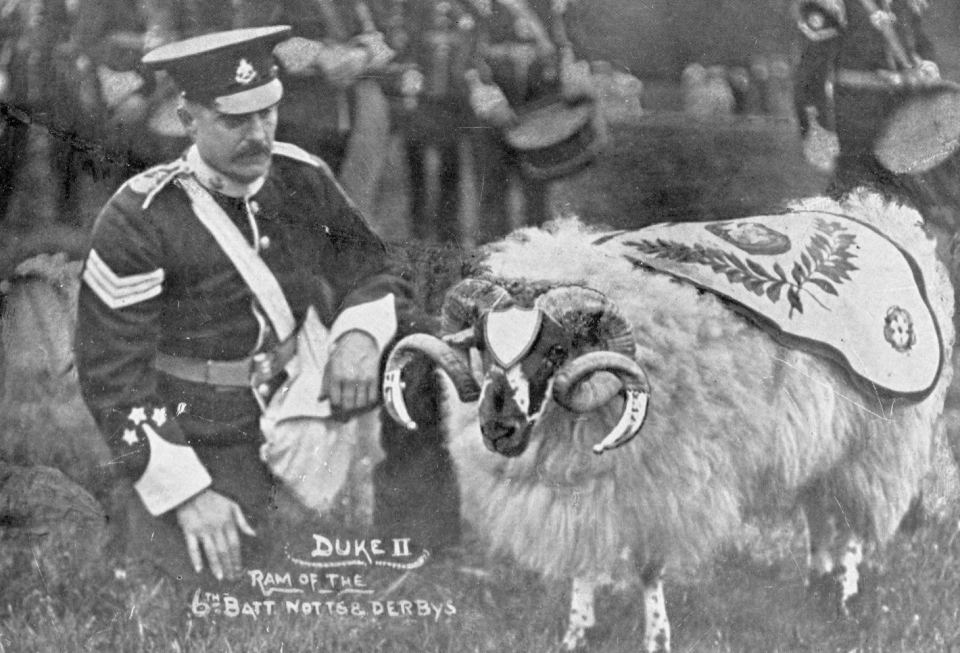 “Duke II Ram of the 6th Batt Notts & Derby” (unknown publisher).
“Duke II Ram of the 6th Batt Notts & Derby” (unknown publisher).
This card was posted by Private William Hughes who came from Ashbourne and was therefore most likely attached to “C” (Buxton and Ashbourne) Company. William Hughes was born in March 1892 and would have been 18 years old at the Hindlow Camp. He was a grocers assistant by trade and this post card was sent to his neighbour, Mrs Hurd in Town Hall Yard in Ashbourne. William was the middle son of Elizabeth, who was a widow and had three other children, Loiuse (b. 1885), Joseph (b. 1888) and Frank (b. 1894).
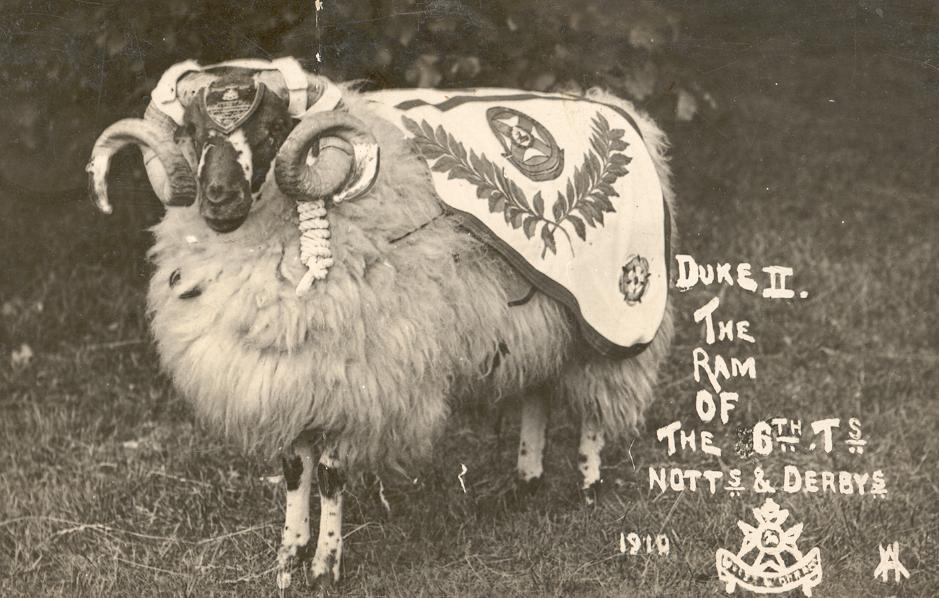 “Duke II. The Ram of the 6th Ts Notts and Derby 1910” (unknown publisher)
“Duke II. The Ram of the 6th Ts Notts and Derby 1910” (unknown publisher)
 This particular card was sent to the nephew of ‘Uncle Robert’ who served with 6 Battalion and who was very proud of the Regimental Mascot. In this postcard we learn that 18,000 men were in the Divisional Camp at Hindlow that year. The card bears the autograph of Colonel Jackson.
This particular card was sent to the nephew of ‘Uncle Robert’ who served with 6 Battalion and who was very proud of the Regimental Mascot. In this postcard we learn that 18,000 men were in the Divisional Camp at Hindlow that year. The card bears the autograph of Colonel Jackson.
 Although the publisher is unknown the card bears a very distinctive emblem. This may indicate that the photographer is Arundel Hall, who was based in the Victoria Arcade, Springs Gardens, Buxton around 1908.
Although the publisher is unknown the card bears a very distinctive emblem. This may indicate that the photographer is Arundel Hall, who was based in the Victoria Arcade, Springs Gardens, Buxton around 1908.
 Untitled picture of men from the 6th Battalion (HP Hansen).
Untitled picture of men from the 6th Battalion (HP Hansen).
The man are seated on what appears to be large canvas bags and are enjoying a quick break. A car can be seen passing the gate on the Chelmorton road. The chimneys from the camp kitchens are also visible in picture.
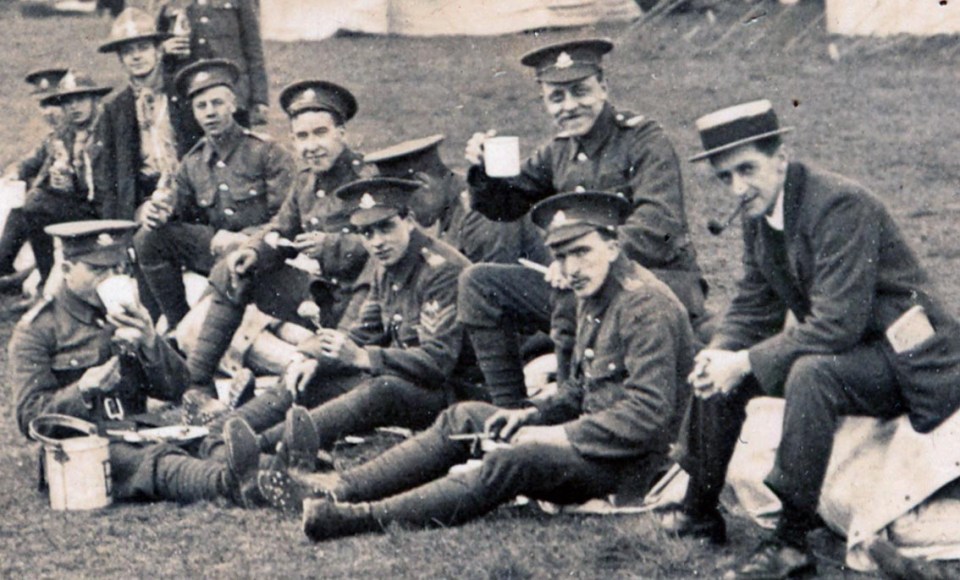 A close up of the group clearly shows the 5-tier Notts & Derby shoulder badge and there is also a Corporal Signaller who may be Corporal A Walker from Chesterfield. Amongst the group are two boys scouts (far left) and a man in civilian clothes (far right).
A close up of the group clearly shows the 5-tier Notts & Derby shoulder badge and there is also a Corporal Signaller who may be Corporal A Walker from Chesterfield. Amongst the group are two boys scouts (far left) and a man in civilian clothes (far right).
The 5th (Derby) Battalion, Notts & Derby
Officers of the 5th (Derby) Battalion
Picture taken by David C Latham (1844-1922) of The Grove Studio, Station Road in Buxton
Untitled picture of men from the 5th Battn (unknown publisher).
A group of men from the 5th (Derby) Battalion are seen drinking tea and eating bread with tinned raspberry jam and pineapple. The stone wall in the background is typical of those in Derbyshire and suggests that this picture was taken in 1910.
An interesting photograph of two men from the 5th Battalion undergoing gymnastic training or a wrestling match.
The pictures was part of the H.P. Hansen YMCA Series of 1910 (#65) but was actually posted from the Scarborough Camp of 1911 (on July 31st). It is addressed to Annie Beresford, a 19 year old domestic servant in the employment of William Brown Esq. who was a corn miller and merchant living at “Rock House” on Kedlestone Road in Derby.
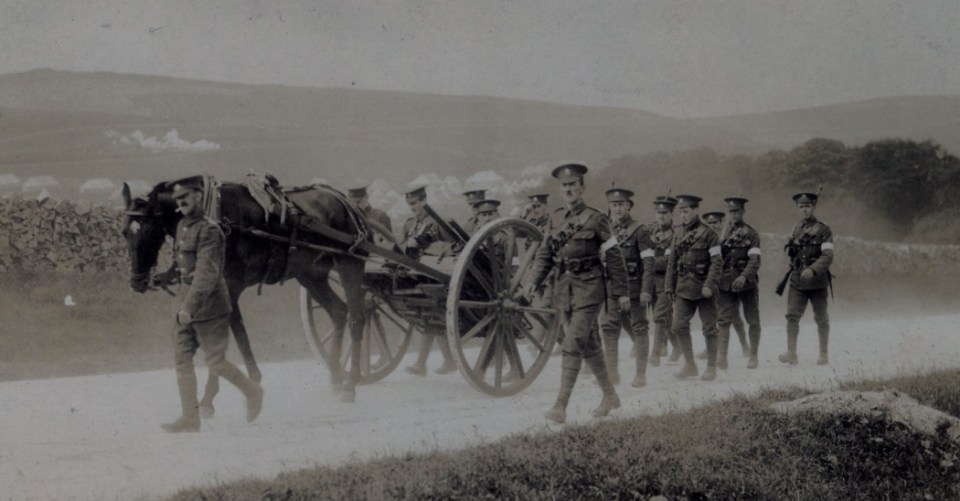 Interesting picture of the 5th (Derby) Battalion Vickers Machine Gun team walking close to the Camp at Shallow Grange.
Interesting picture of the 5th (Derby) Battalion Vickers Machine Gun team walking close to the Camp at Shallow Grange.
 The card is part of a series published by JH Waterhouse of Chesterfield
The card is part of a series published by JH Waterhouse of Chesterfield
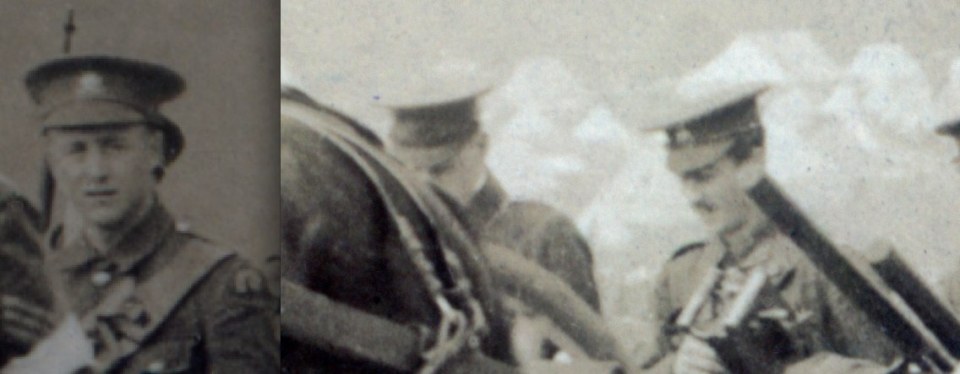 Interestingly, at least one of the men is still wearing the old Volunteer shoulder badge. The Officers are possibly Captain Newton and Lt H Rudgard who was machine gun Officer when the Battalion went to France in February 1915. Other possibilities include Lieutenants Claye or Coles.
Interestingly, at least one of the men is still wearing the old Volunteer shoulder badge. The Officers are possibly Captain Newton and Lt H Rudgard who was machine gun Officer when the Battalion went to France in February 1915. Other possibilities include Lieutenants Claye or Coles.
Signallers at Hindlow Camp
Church Parades and Inspections
 “5th, 6, 7 & 8 Battn” (HP Hansen series #123)
“5th, 6, 7 & 8 Battn” (HP Hansen series #123)
The Notts and Derby Brigade at Hindlow Camp in August 1910. The Brigade comprised the 5th (Derby), 6th (Derbyshire), 7th (Nottingham) and 8th (Nottinghamshire) Battalions of the Notts and Derby (Sherwood Foresters) Regiment. The entire Brigade is assembled for a review by General Sir John French, G.C.B. on August 11th. The 5th and 6th Battalions are at the front, whilst the 7th and 8th Battalions are at the rear of the field.
The 6th Battalion prepares to be inspected. To the far right of the formation are the Battalion Band and some of these men can be seen with their trumpets and trombones. Standing in front is 1251 Act Sergeant-Major J Shepherd who at the time of this photograph was attached to “G” (Clay Cross) Company.
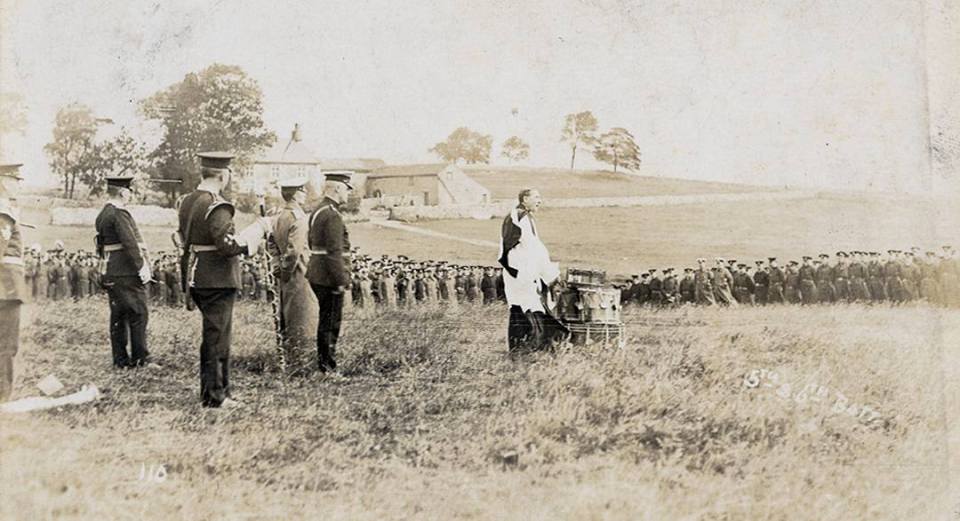 “5th & 6th” (HP Hansen series #110)
“5th & 6th” (HP Hansen series #110)
Drum Head Church Parade for the 5th and 6th Battalions. After breakfast on Sunday preparations were made for Church Parade. The Officer closest to the Chaplain is Colonel Murray, late Royal Scots, who took over command of the Notts and Derby Brigade in 1909.
Companies of the 6 Battalion are awaiting the start of the Church Parade. In the middle is Colonel Murray, whilst Lieutenants Valentine Langford and Arthur Shea are amongst the Officers to the right. The altar is made from four drums belonging to the Battalion Band.
The Military Parade through Buxton
On the afternoon of Monday 8th August, 8000 troops of the North Midland Division marched through the town of Buxton. The column of men stretched for over 2 miles but to the disappointment of many ‘Buxtonians’ the men marched in service dress.
The route of the procession went from the Camp at Hindlow along London Road (now the A515), across Market Place, down Terrace Road, through the Crescent and into Buxton Gardens where hundreds of Buxton residents were there to greet them. General Archdale, Colonel Thompson and Captain Powel rode at the head of the Column, which was reviewed by the Duke of Devonshire on the Crescent. From Buxton Gardens the men marched back to Camp via St John’s Road to Burbage and then on to Harpur Hill. The 6th Battalion marched with their Regimental Ram, Duke II, and each Battalion also had a machine gun, which generated great interest amongst the spectators.
In total the Column comprised ten Infantry Battalions, a Corps of Engineers, the A.S.C. and the R.A.M.C. In addition the men were accompanied by Eleven bands and twelve drum and bugle bands and ten machine guns, together with transport and ambulance wagons. Accompanying the 2nd North Midland Field Ambulance were Colonel Peake’s well known ambulance dogs, which had been trained to carry water bottles and other equipment on the battlefield, to find the wounded and call attention to them by barking or ringing a bell if the wounded soldier was too injured to help himself. Once the Column reached Burlington Street General Archdale and his entire staff went ahead and took up a position on at the entrance to Park Road. As the Column passed each Battalion Commander shouted “eyes right” and every man turned to the General, who in turn saluted.
Band concerts were arranged in Buxton Gardens between 6 and 8 each evening and a military tattoo took place during the evening of Saturday August 13th. From the 1st to 10th August the 1st and 2nd North Midland Field Company, Royal Engineers built pontoons on the Lake in the Gardens.
General Sir JDP French GCB, GCVO KCMG arrived in Buxton on Wednesday 10th August by the 6.10 pm Midland train and was accompanied by Brigadier-General D Henderson CB, DSO, and Lord Brooke ADC MV. As part of his tour he inspected the pontoon bridge that had been built by the Engineers.
Notts and Derby Brigade Field Day
The Notts and Derby Brigade field day took place on Thursday 11th August and had been eagerly anticipated by the men. The tactical scheme had been prepared by Colonel Murray and took place at Upper Edge, which was to the north-west of Hindlow Station (above). The scheme to which the Notts & Derby Brigade worked had the blue force (Notts & Derby) attack and capture a strong position at Brierlow but finding Hindlow strongly entrenched and this position and Upper Edge held by the Red force. The attack commenced from a line due east and west of Glutton Bridge and they fought their way over Top Edge and spread themselves in the area of the “Quiet Woman” Pub in Earl Sterndale (below). At this time news came that the red force was in the neighbourhood of Buxton and the blue force worked its way left and right, with the idea of trapping them near to Upper Edge. During the afternoon of 11th August General French made a tour of the Camp and later in the evening inspected the men of the 6th Battalion.
 The 6th Battalion marching into Camp after “the great battle” on Upper Edge. This picture shows Captain Arthur Hopkins leading the men of “A” (Chesterfield) Company into Camp following the Notts and Derby Brigade Field day. “B” (Chapel-en-le-frith) Company won the Commanding Officers Prize for the best turned-out Company in the new leather bandolier equipment, which had been issued to the battalion in camp.
The 6th Battalion marching into Camp after “the great battle” on Upper Edge. This picture shows Captain Arthur Hopkins leading the men of “A” (Chesterfield) Company into Camp following the Notts and Derby Brigade Field day. “B” (Chapel-en-le-frith) Company won the Commanding Officers Prize for the best turned-out Company in the new leather bandolier equipment, which had been issued to the battalion in camp.
North Midland Division
The Lincolnshire Regiment

5th South Staffordshire Regiment
Two post cards confirming that 1910 was a North Midland Division Camp with men of the Lincolnshire and Staffordshire Brigades. J. S. Simnett was a well-known photographer from Burton-on-Trent and regularly attended the Annual Camps. This family run business was established in 1863 and are still in their original premises on Guild Street in Burton.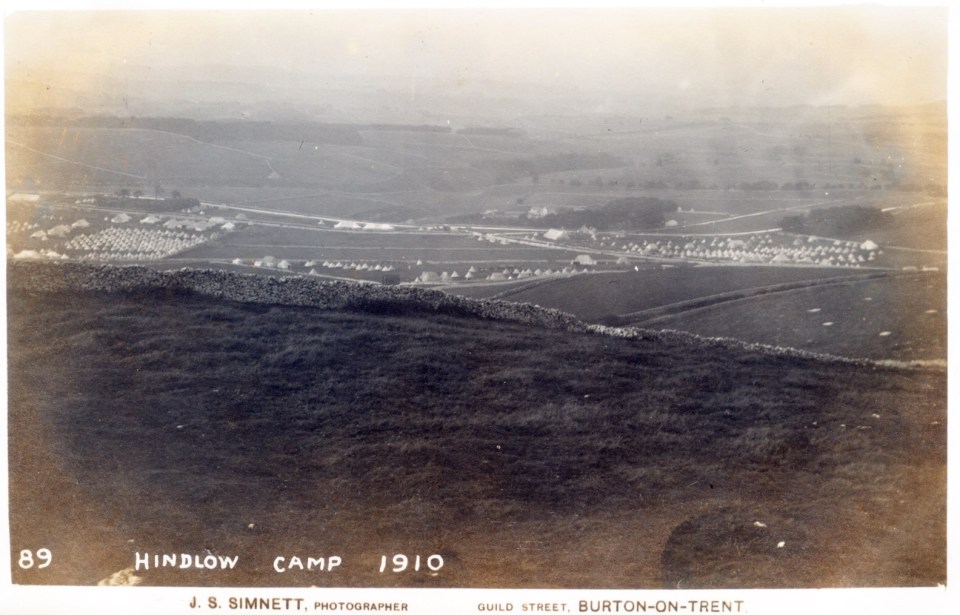
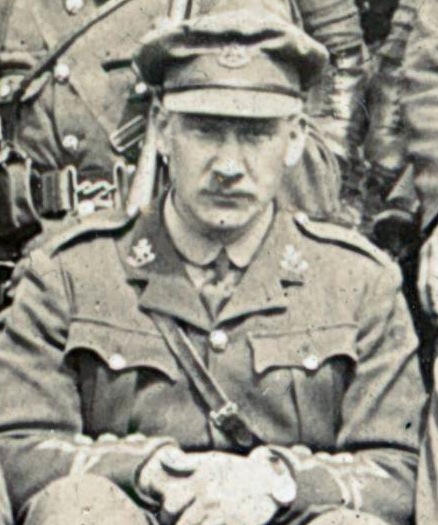 A group of men from the North Staffordshire Regiment and amongst them is an Officers of the Notts & Derby Regiment.
A group of men from the North Staffordshire Regiment and amongst them is an Officers of the Notts & Derby Regiment.
Other Notable Events from 1910
Strength of the Battalion on 31st December 1910 was 29 Officers and 986 Other ranks. In addition there were two Medical Officers, 2 Chaplains, 1 Adjutant (Captain EM Atkinson) and 8 Instructor Sergeants posted to the individual Companies:-
Officers:-
- Major Christopher Barker Symonds restored to the Establishment from the Supernumerary List on August 21st 1909, but resigned his Commission on June 25th 1910.
- Captain Godfrey Davenport Goodman was gazetted Major on 25th June 1910.
- Surgeon Arthur Wilson Shea promoted Captain.
- Lieutenant Valentine Henry Elwes Langford promoted Captain and appointed to Command C Company.
- Lieutenant Guy Nicholson promoted Captain and appointed to Command G Company.
- Lieutenant Henry Welch promoted Captain and appointed to Command B Company.
- Captain Reginald Turner DSO resigned his Commission.
- Captain Joseph Albert Wheatcroft resigned his Commission.
- Captain Robert Stuart Hilton resigned his Commission.
- Lieutenant Charles Henry Dakeyne Dawson resigned his Commission.
- Joseph Harry Mason Humbble gazetted to the Battalion.
- Cyril John Wheatcroft gazetted to the Battalion.
- Eric Algernon Tollemache gazetted to the Battalion.
- Victor Owen Robinson gazetted to the Battalion.
- Charles Victor Henry Cheetham Blackwall gazetted to the Battalion.
- Cyril Benton Johnson gazetted to the Battalion.
Eight Sergt.-Instructors posted as follows:-
- Chesterfield: 755 Colour-Sergeant James Arthur Sturges (755 Col.-Sergt.-Instr. JA Sturgess previously held the rank of Sergeant in the 1st Battalion and was Colour Sergeatn of Militia Permanent Staff. He was discharged to pension in 1911 and awarded LSM in 1902).
- Chapel-en-le-Frith: Colour-Sergeant ML Jackson (Served in Tirah and held rank of Col.Sergt in the 2nd Battn).
- Ashbourne: Col.-Sergt. O Wain (Served with the 2nd Battn in Tirah and also a Col.-Sergt. in the 1st Battn).
- Bakewell: Colour-Sergeant Edward Pullen (Was a Sergt in the 2nd Battn and served with E Company in Tirah and with the Mounted Infantrt in South Africa. Was lately Col.-Sergt Instructor of Musketry with 4th Battn).
- Wirksworth: Sergeant J Turner (from the 2nd Battn).
- Staveley: Colour-Sergeant William James Keery (Later Commissioned as Lieut. & Qquartermaster).
- Clay Cross: 1251 Act Sergeant-Major John Shepherd (Colour Sergeant of H Company, 2nd Battn and served in Tirah. Awarded LSM in 1904).
- Whaley Bridge: Colour-Sergeant William Seaton (Held rank of Colour-Sergeant in the 1st Battalion and served with No 1 Company Mounted Infantry in South Africa. He was recommended for the VC but was awarded the DCM).
- Colour-Sergeant S Cocker discharged to Pension (Served with 2nd Battn in Tirah)
- Colour-Sergeant O Wain awarded LSM.
- Sergeant J Turner posted from 2nd Battn to E Company as Sergeant-Instructor.
- Colour-Sergeant Instructor J Spencer discharged to Pension (Served in South Africa and from 4th Battn Staff).
- Colour-Sergeant Instructor ML Jackson continued Service beyond 21 years.
- Colour-Sergeant WJ Keery posted from 1st Battn.
- Colour-Sergeant Instructor Seaton awarded RSA certificate.
- Colour-Sergeant Instructor WL Jackson awarded RSA certificate.
- Colour-Sergeant Instructor O Wain awarded RSA certificate.
- Colour-Sergeant O Hoult awarded TEM.
Men known to have enlisted into the 6th Battalion during 1910:-
- 1216 Thomas Hambleton
- 1220 Charles F Cooper
- 1226 HA Smith
- 1227 Stephen Middleton
- 1231 Harry Widdowson
- 1235 George Silcock
- 1246 William Hopkinson
- 1250 George Hill
- 1265 Dudley W Spicer
- 1266 Herbert H Smith
- 1283 William GH Johnson
- 1285 John Dickson Warde Nesbitt
- 1287 George William Mycock
- 1290 Ernest Sanderson
- 1292 George F Lee
- 1294 George Howe
- 1296 Graham Cherry
- 1298 George E Summers
- 1299 Cyril A Mills
- 1300 Philip Mills
- 1301 Alfred Gent
- 1304 Alfred C Johnson







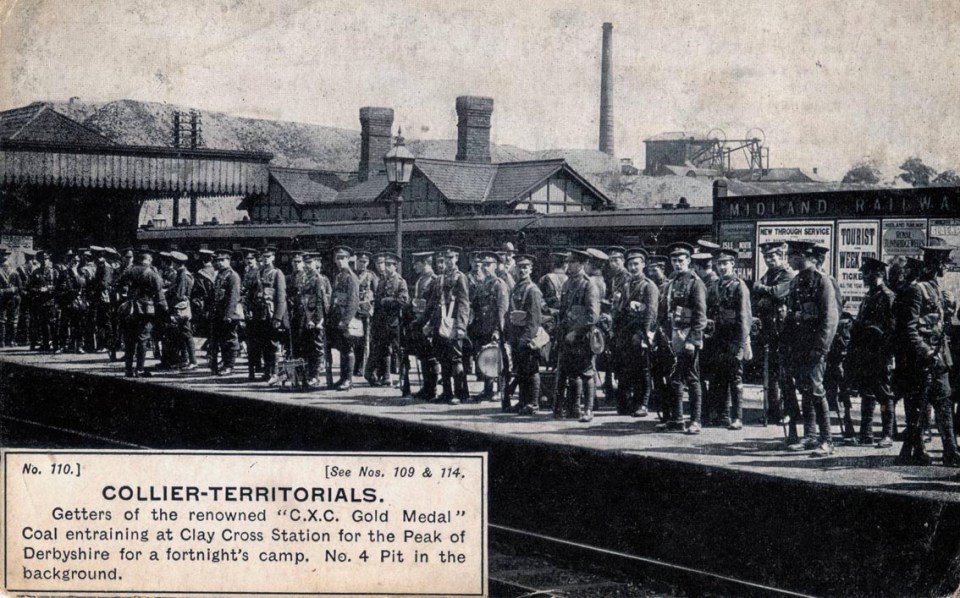
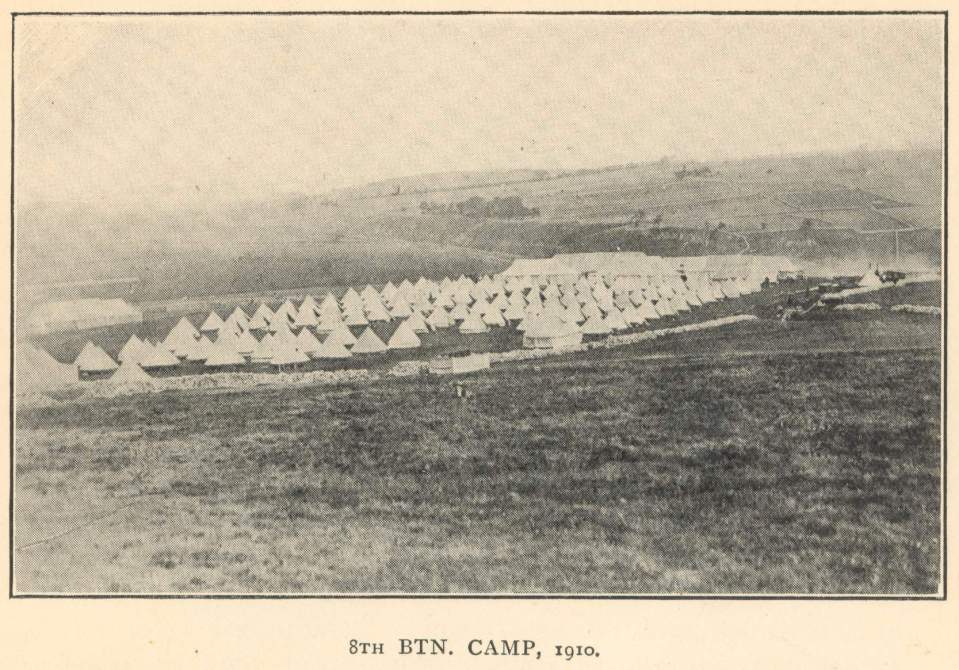
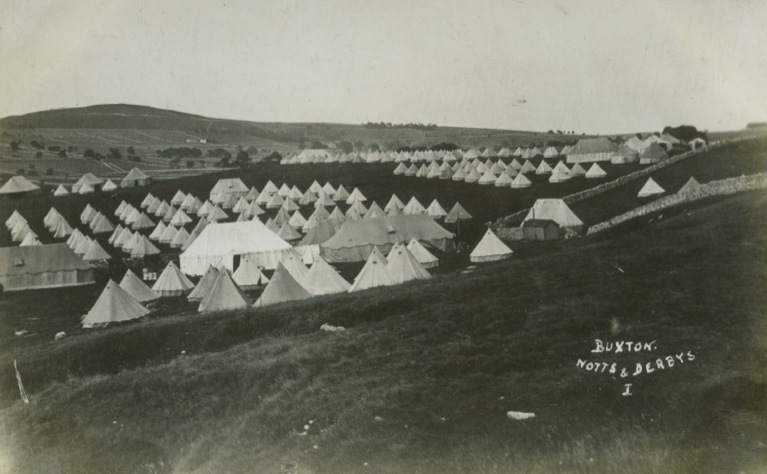


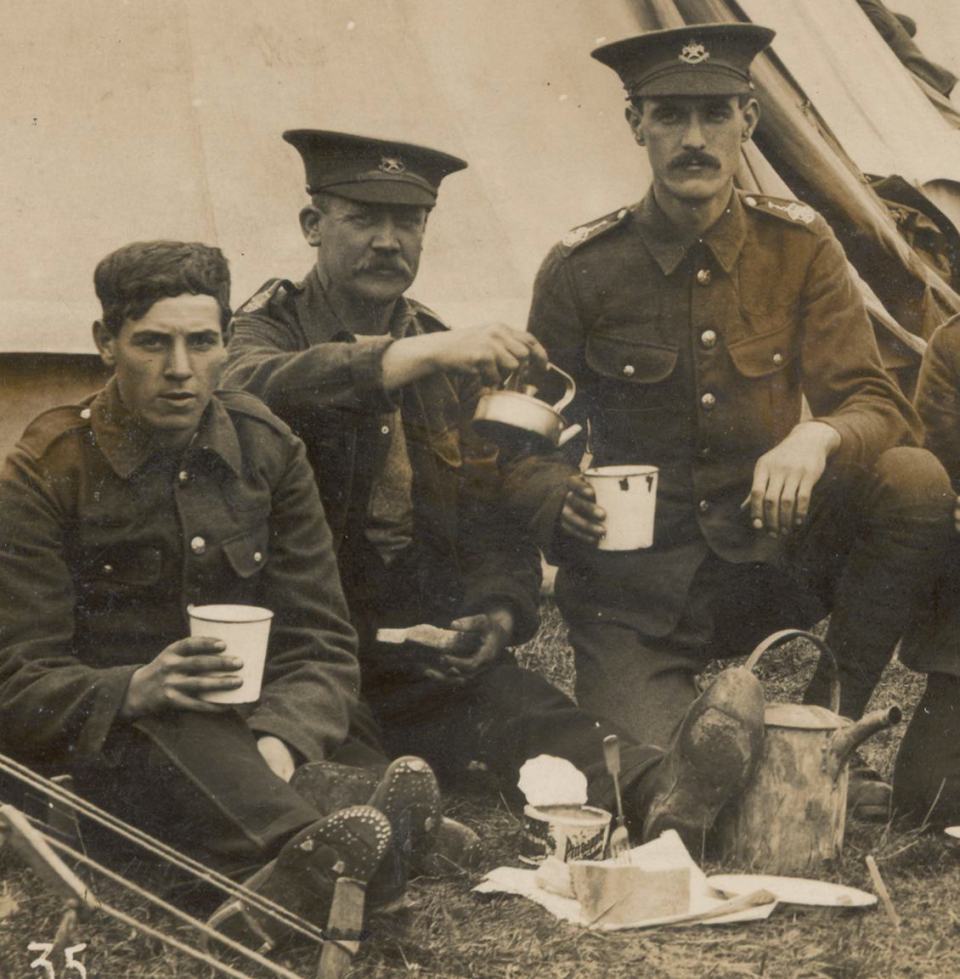
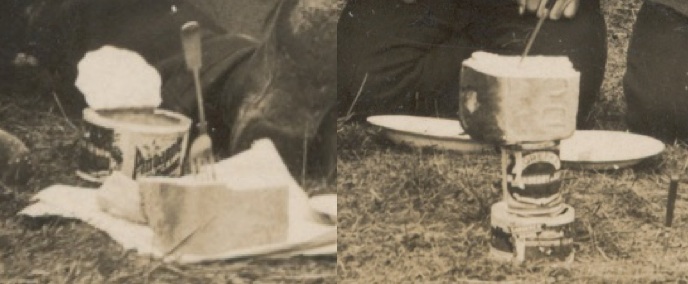
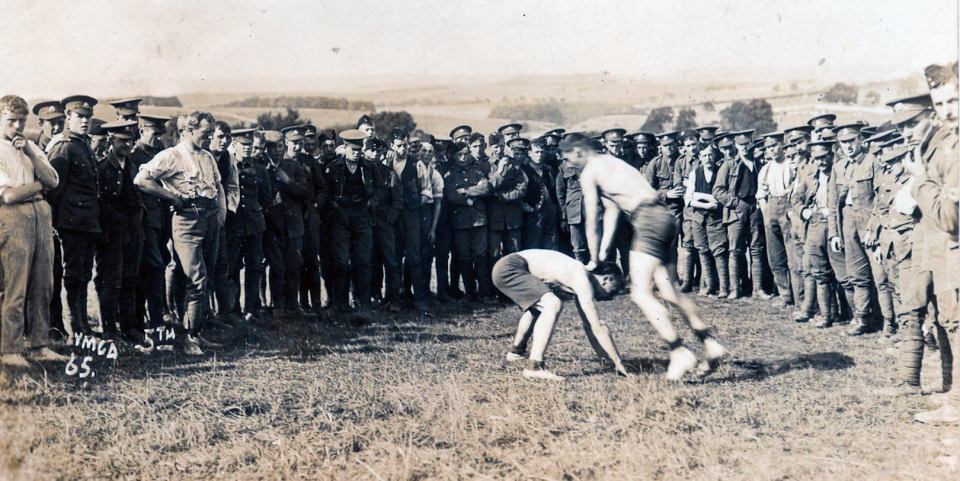









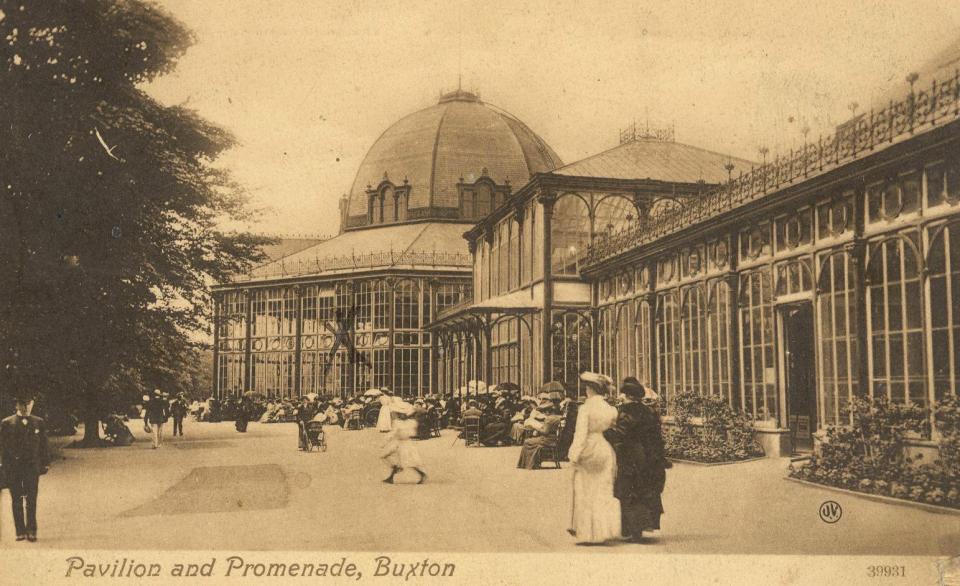


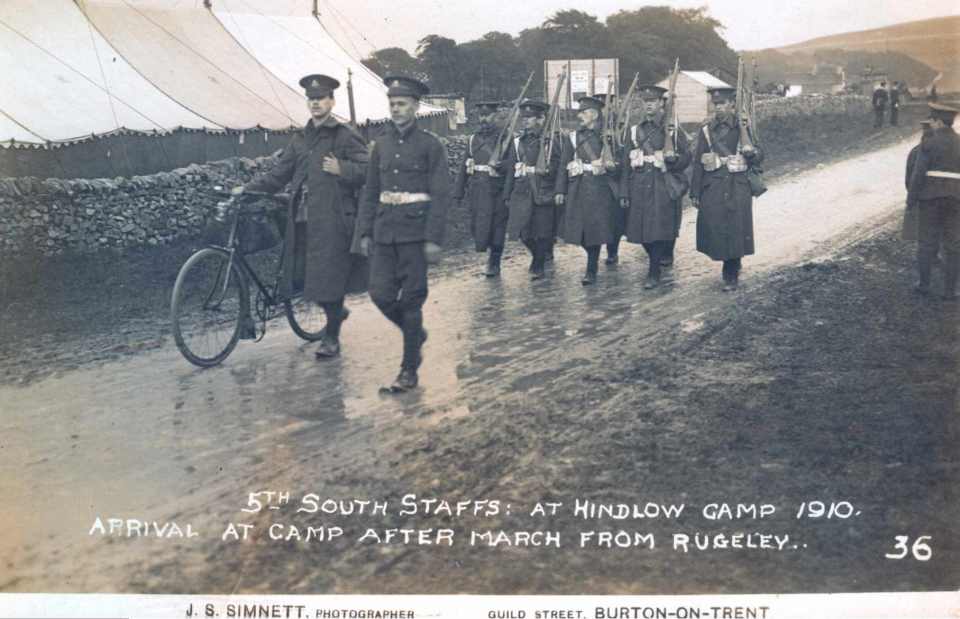

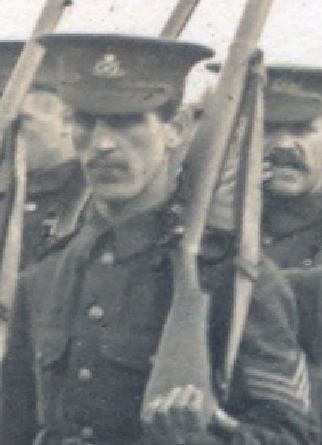

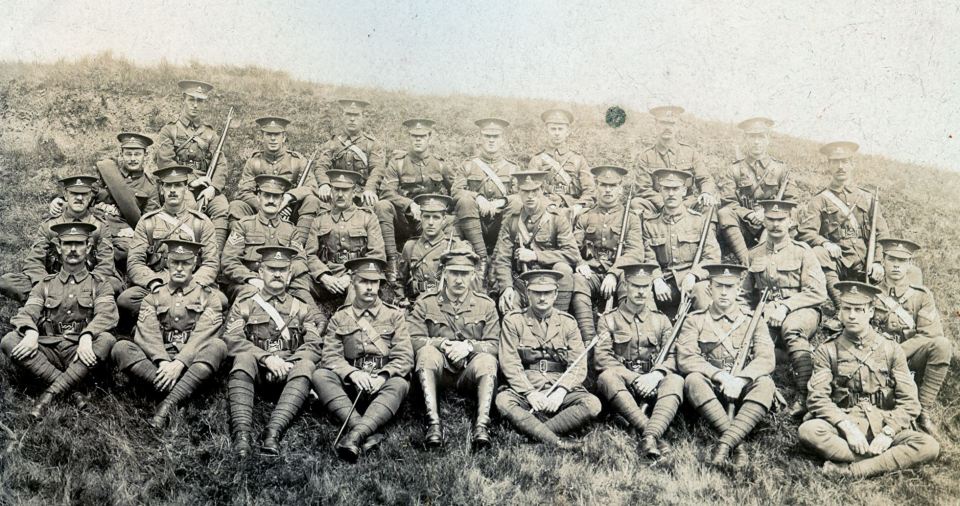

Superb – never seen such a display of pre-War Territorial Annual Camps as these. Thanks for sharing them. Regards Graham
Thanks Graham – glad you like them – it was fun putting them all together and trying to identify places and men.
Hello Mike. This is a fascinating web site. I am researching a relative who attested in 1908 for the Notts Horse Artillery Battery, He was at Wiseton Park in 1909, transferred as a Driver in 1910 to the Army Service Corps and was at Hindlow in 1910. How do you work out which Battalion people were in. I cannot see anything on his army papers. He enlisted again in 1913 into the Lincs Leics Brigade Coy ASC. Would he have been amongst the men in the photo’s above. Thanks for any pointers.
Hello Gail
Many thanks for your nice comments. I’m travelling at moment but will send a longer answer ASAP
cheers
Mike